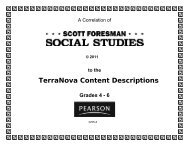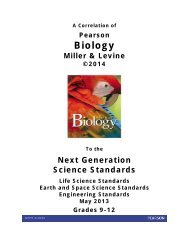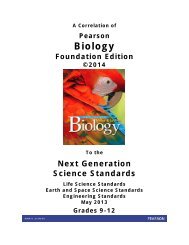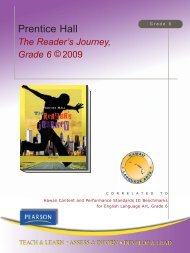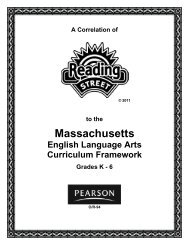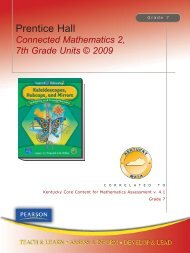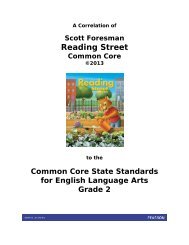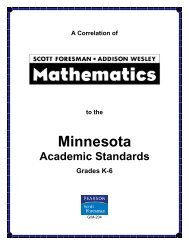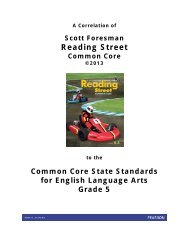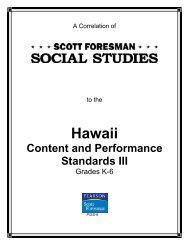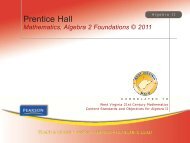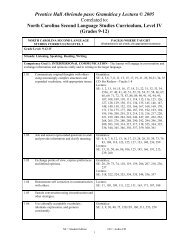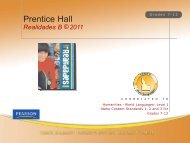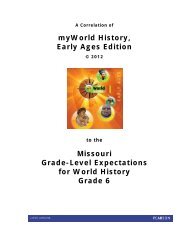Prentice Hall Earth Science (Tarbuck/Lutgens) ©2006 ... - Pearson
Prentice Hall Earth Science (Tarbuck/Lutgens) ©2006 ... - Pearson
Prentice Hall Earth Science (Tarbuck/Lutgens) ©2006 ... - Pearson
You also want an ePaper? Increase the reach of your titles
YUMPU automatically turns print PDFs into web optimized ePapers that Google loves.
<strong>Prentice</strong> <strong>Hall</strong> <strong>Earth</strong> <strong>Science</strong> (<strong>Tarbuck</strong>/<strong>Lutgens</strong>) ©2006<br />
Correlated to:<br />
District of Columbia <strong>Earth</strong> <strong>Science</strong> Year At A Glance Course Overview and <strong>Earth</strong> <strong>Science</strong> Standards<br />
(High School)<br />
UNIT<br />
Unit 1: Expanding<br />
Understanding<br />
POWER STANDARDS COVERED<br />
ES.2.1. Recognize that the universe contains many billions<br />
of galaxies, and each galaxy contains many billions of<br />
stars.<br />
PAGE (S) WHERE TAUGHT<br />
(If submission is not a text,<br />
cite appropriate resource(s))<br />
SE/TE: 6, 614, 715-721; Big<br />
Ideas: 698C; Star Charts: 748-<br />
749<br />
ES.2.3. Describe Hubble’s law, and understand the big<br />
bang theory and the evidence that supports it (microwave<br />
background radiation, relativistic Doppler effect).<br />
SE/TE: 6, 698C-698D, 718, 719,<br />
720-721<br />
Unit 2: Star Search<br />
ES.2.4. Explain the basics of the fusion processes that are<br />
the source of energy of stars.<br />
SE/TE: 689-690, 698C, 700-<br />
706, 707-709, 710-711<br />
1st advisory<br />
ES.2.7. Describe how elements with an atomic number<br />
greater than helium have been formed by nuclear fusion<br />
processes in stars, supernova explosions, or exposure to<br />
cosmic rays.<br />
ES.2.6. Analyze the life histories of stars and different<br />
types of stars found on the Hertzsprung-Russell diagram,<br />
including the three outcomes of stellar evolution based on<br />
mass (black hole, neutron star, white dwarf).<br />
SE/TE: 6, 35, 37, 347, 689-690,<br />
707-714<br />
SE/TE: 704-706, 707-714<br />
ES.1.15. Observe natural phenomena and analyze their<br />
location, sequence, or time intervals (e.g., relative ages of<br />
rocks, locations of planets over time, and succession of<br />
species in an ecosystem).<br />
SE/TE: 3, 7, 18-22, 23, 34, 80-<br />
84, 85, 94-100, 117, 148-149,<br />
158-159, 180, 188-197, 218-<br />
219, 238-239, 271, 308-313,<br />
325, 332, 336-337, 343-351,<br />
352-355, 364-368, 369-376,<br />
377-381, 382-384, 438-439,<br />
461, 604-605, 622-629, 644-<br />
648, 649-653, 654-659, 666-<br />
667<br />
1<br />
SE = Student Edition - TE = Teacher's Edition
<strong>Prentice</strong> <strong>Hall</strong> <strong>Earth</strong> <strong>Science</strong> (<strong>Tarbuck</strong>/<strong>Lutgens</strong>) ©2006<br />
Correlated to:<br />
District of Columbia <strong>Earth</strong> <strong>Science</strong> Year At A Glance Course Overview and <strong>Earth</strong> <strong>Science</strong> Standards<br />
(High School)<br />
UNIT<br />
Unit 3: Home on the Range<br />
POWER STANDARDS COVERED<br />
ES.3.1. Describe the location of the solar system in an<br />
outer edge of the disc-shaped Milky Way galaxy, which<br />
spans 100,000 light years.<br />
ES.3.3. Understand and describe the nebular theory<br />
concerning the formation of solar systems, including the<br />
roles of planetesimals and protoplanets.<br />
PAGE (S) WHERE TAUGHT<br />
(If submission is not a text,<br />
cite appropriate resource(s))<br />
SE/TE: 3, 4, 614, 644, 715-716;<br />
Exploration Lab: 666-667<br />
SE/TE: 3, 4, 647, 648, 708<br />
2nd advisory<br />
Unit 4: A Global Perspective<br />
ES.1.13. Apply mathematical relationships involving<br />
proportionalities, linear relations, quadratic equations,<br />
simple trigonometric relationships, exponential growth and<br />
decay laws, and logarithmic relationships to scientific<br />
situations.<br />
ES.4.1. Examine and describe the structure, composition,<br />
and function of <strong>Earth</strong>’s atmosphere, including the role of<br />
living organisms in the cycling of atmospheric gases.<br />
ES.4.2. Investigate and describe the composition of the<br />
<strong>Earth</strong>’s atmosphere as it has evolved over geologic time<br />
(outgassing, origin of atmospheric oxygen, variations in<br />
carbon dioxide concentration).<br />
SE/TE: Math Practice: 17, 43,<br />
132, 163, 198, 221, 368, 400,<br />
437, 460, 493, 509, 542, 621,<br />
648, 664, 690; Integrate Math:<br />
15, 161, 225, 395; Skills: 729,<br />
730, 736-740; Appendix: 741,<br />
756<br />
SE/TE: 7, 8, 9, 19, 34, 42, 85,<br />
110, 366-367, 476-480, 494-<br />
495, 504, 506, 523, 578, 591,<br />
646<br />
SE/TE: 8, 34, 42, 85, 110, 477-<br />
478, 487, 494-495, 504, 523,<br />
602-603<br />
ES.4.9. Describe the development and dynamics of<br />
climatic changes over time corresponding to changes in<br />
the <strong>Earth</strong>’s geography (plate tectonics/continental drift),<br />
orbital parameters (the Milankovitch cycles), and<br />
atmospheric composition.<br />
SE/TE: 198, 248-253, 254-257,<br />
258-264, 265-268, 365, 366,<br />
367, 450, 588-590, 600-601,<br />
691<br />
2<br />
SE = Student Edition - TE = Teacher's Edition
<strong>Prentice</strong> <strong>Hall</strong> <strong>Earth</strong> <strong>Science</strong> (<strong>Tarbuck</strong>/<strong>Lutgens</strong>) ©2006<br />
Correlated to:<br />
District of Columbia <strong>Earth</strong> <strong>Science</strong> Year At A Glance Course Overview and <strong>Earth</strong> <strong>Science</strong> Standards<br />
(High School)<br />
UNIT<br />
POWER STANDARDS COVERED<br />
PAGE (S) WHERE TAUGHT<br />
(If submission is not a text,<br />
cite appropriate resource(s))<br />
3rd advisory<br />
Unit 5: Weather Water<br />
ES.1.1. Know the elements of scientific methodology<br />
(identification of a problem, hypothesis formulation and<br />
prediction, performance of experimental tests, analysis of<br />
data, falsification, developing conclusions, reporting<br />
results) and be able to use a sequence of those elements<br />
to solve a problem or test a hypothesis. Also, understand<br />
the limitations of any single scientific method (sequence of<br />
elements) in solving problems.<br />
ES.4.6. Determine the origins, life cycles, behavior, and<br />
prediction of weather systems.<br />
ES.4.8. Explain special properties of water (e.g., high<br />
specific and latent heats) and the influence of large bodies<br />
of water and the water cycle on heat transport and,<br />
therefore, weather and climate.<br />
ES.1.10. Select and use appropriate tools and technology<br />
to perform tests, collect data, analyze relationships, and<br />
display data. (The focus is on manual graphing,<br />
interpreting graphs, and mastery of metric measurements<br />
and units, with supplementary use of computers and<br />
electronic data gathering when appropriate.)<br />
SE/TE: 23-24; Inquiry Activity:<br />
1, 33, 65, 93, 247, 335, 503,<br />
531, 557; Exploration Lab: 26-<br />
27, 86-87, 150-151, 326-327,<br />
356-357, 468-469, 496-497,<br />
524-525, 550-551; Build<br />
<strong>Science</strong> Skills-Designing<br />
Experiments: 54, 78, 100, 127,<br />
167, 195; <strong>Science</strong> Skills: 728-<br />
731<br />
SE/TE: 476, 481, 515, 522, 532-<br />
536, 537-539, 540-541, 546-<br />
549, 557, 558-563, 564-570,<br />
571-572, 573-577, 578-579,<br />
580-581<br />
SE/TE: 156C-156D, 157, 158-<br />
159, 171-174, 424-425, 448-<br />
453, 484, 488, 489, 496-497,<br />
504-509, 543-544, 546-548,<br />
560-562, 576-577, 578-579,<br />
588-590, 596, 601<br />
SE/TE: 729, 735, 740, 741,<br />
756; Application Lab: 118-119;<br />
Quick Lab: 226; Exploration<br />
Lab: 26-27, 58-59, 86-87, 150-<br />
151, 181, 240-241, 272-273,<br />
300-301, 326-327, 414-415,<br />
440-441, 468-469, 496-497,<br />
524-525, 550-551, 606-607,<br />
666-667, 692-693, 723<br />
3<br />
SE = Student Edition - TE = Teacher's Edition
<strong>Prentice</strong> <strong>Hall</strong> <strong>Earth</strong> <strong>Science</strong> (<strong>Tarbuck</strong>/<strong>Lutgens</strong>) ©2006<br />
Correlated to:<br />
District of Columbia <strong>Earth</strong> <strong>Science</strong> Year At A Glance Course Overview and <strong>Earth</strong> <strong>Science</strong> Standards<br />
(High School)<br />
UNIT<br />
POWER STANDARDS COVERED<br />
PAGE (S) WHERE TAUGHT<br />
(If submission is not a text,<br />
cite appropriate resource(s))<br />
Unit 6: Solid as a Rock<br />
ES.6.1. Differentiate among the processes of weathering,<br />
erosion, transportation of materials, deposition, and soil<br />
formation.<br />
ES.6.2. Illustrate the various processes and rock types that<br />
are involved in the rock cycle, and describe how the total<br />
amount of material stays the same throughout formation,<br />
weathering, sedimentation, and reformation.<br />
SE/TE: 66, 67-69, 76, 78, 125,<br />
126-132, 133-134, 135-137,<br />
140-142, 143-147, 148-149,<br />
164, 165, 166-168, 188-189,<br />
192, 193, 194, 199, 203, 204,<br />
208-209, 464-466, 506; Big<br />
Ideas: 124C<br />
SE/TE: 65, 66, 67-69, 70-74, 75-<br />
79, 80-84, 86-87, 308-313<br />
Unit 7: Go with the Flow<br />
ES.5.2. Describe the processes of the hydrologic cycle,<br />
including evaporation, condensation, precipitation, surface<br />
runoff, and groundwater percolation, infiltration, and<br />
transpiration.<br />
ES.7.6. Observe and explain how rivers and streams are<br />
dynamic systems that erode and transport sediment,<br />
change their course, and flood their banks in natural and<br />
recurring patterns.<br />
SE/TE: 109, 156C, 158-159,<br />
171-179, 452-453, 503, 504-<br />
509, 515, 516, 520-522, 548<br />
SE/TE: 142, 143, 160-161, 162-<br />
163, 164-170, 200-201, 208-<br />
209<br />
4th advisory<br />
ES.1.14. Recognize the implications of statistical variability<br />
in experiments, and explain the need for controls in<br />
experiments.<br />
ES.1.16. Read a topographic map and a geologic map for<br />
information provided on the maps.<br />
SE/TE: 613, 730-731<br />
SE/TE: 11, 12, 13, 14, 15, 26-<br />
27, 95, 112, 166, 168, 210-211,<br />
240-241, 252, 256-257, 271,<br />
294, 296-297, 316, 378, 395,<br />
449, 493, 548, 561, 594-595,<br />
598; Appendix: 744-745, 752-<br />
755<br />
4<br />
SE = Student Edition - TE = Teacher's Edition
<strong>Prentice</strong> <strong>Hall</strong> <strong>Earth</strong> <strong>Science</strong> (<strong>Tarbuck</strong>/<strong>Lutgens</strong>) ©2006<br />
Correlated to:<br />
District of Columbia <strong>Earth</strong> <strong>Science</strong> Year At A Glance Course Overview and <strong>Earth</strong> <strong>Science</strong> Standards<br />
(High School)<br />
UNIT<br />
POWER STANDARDS COVERED<br />
PAGE (S) WHERE TAUGHT<br />
(If submission is not a text,<br />
cite appropriate resource(s))<br />
Unit 8: Shake, Rattle, and Roll<br />
ES.7.2. Analyze the evidence that supports the hypothesis<br />
of movement of the plates (from paleomagnetism,<br />
paleontology, paleoclimate, and the continuity of<br />
geological structure and stratigraphy across ocean basins).<br />
SE/TE: 9-10, 246C-246D, 253,<br />
254-257, 258-264, 265-268,<br />
269-270, 272-273, 293-297<br />
ES.6.3. Explain the absolute and relative dating methods<br />
used to measure geologic time.<br />
ES.1.5. Distinguish between a conjecture (guess), a<br />
hypothesis, and a theory as these terms are used in<br />
science.<br />
ES.7.5. Explain why, how, and where earthquakes occur;<br />
how they are located and measured; and the ways that<br />
they can cause damage (directly by shaking and<br />
secondarily by fire, tsunami, landsliding, or liquefaction).<br />
SE/TE: 38, 336, 337-342, 349-<br />
350, 351, 352-355<br />
SE/TE: 23-24, 319, 338, 385,<br />
406, 720-721; Inquiry Activity:<br />
33, 65, 247, 335, 503, 531,<br />
557; Exploration Lab: 150-151,<br />
210-211, 240-241, 272-273,<br />
300-301, 326-327, 414-415,<br />
440-441, 468-469, 636-637;<br />
<strong>Science</strong> Skills: 730-731<br />
SE/TE: 145, 216C-216D, 217,<br />
218-221, 222-228, 229-232,<br />
238-239, 240-241, 266-267,<br />
333<br />
5<br />
SE = Student Edition - TE = Teacher's Edition



